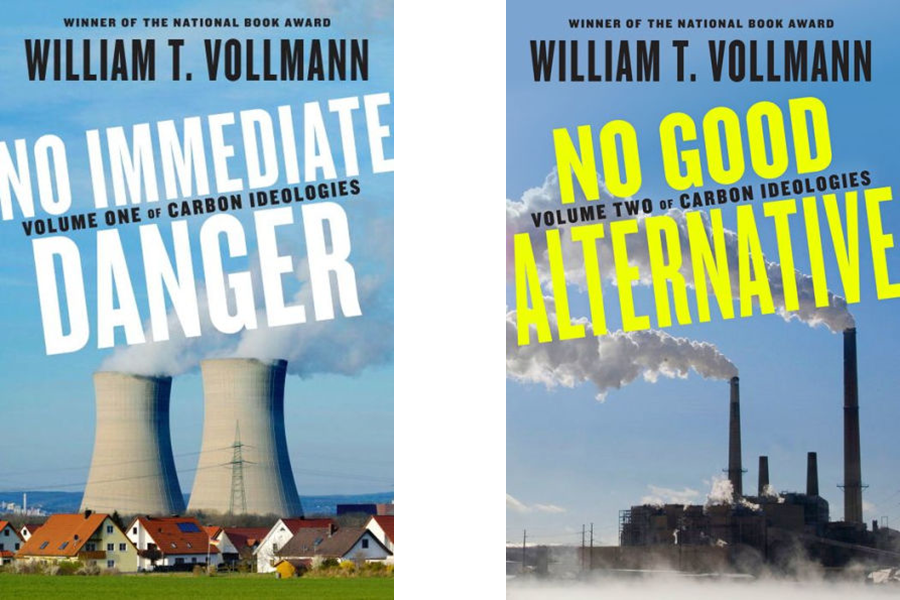'Carbon Ideologies' examines – exhaustively – non-renewable energy
Loading...
The latest work from National Book Award-winning author William Vollmann is a thing of nearly monstrous ambition. Carbon Ideologies is a 1,200-page book published in two 600-page volumes of fierce, relentless clarification (the Table of Contents has footnotes), studying at exhaustive length modern humanity's relationship with non-renewable energy sources like coal, natural gas, oil, and most of all nuclear power.
Volume 1 – "No Immediate Danger," which Vollmann himself refers to, with alarming candor, as “particularly uninviting” – concentrates on the larger picture and the end game, the broader reality of climate change, and then moves to examine nuclear energy in particular. Volume 2, "No Good Alternative," turns to the industries of coal and natural gas and oil, laying out the facts and including extensive interviews with everybody involved, from miners to merchants to energy tycoons.
The whole work is framed in a past-tense conceit in which the world has been ravaged by climate change and humanity has been devastated, a barren, blasted world whose traumatized inhabitants will look back at the late 20th and early 21st century with a combination of confusion and anger. “Now that we are all gone, someone from the future is turning this book's brittle yellow pages,” he writes. “Unimpressed with what I have written so far, he wishes to know why I didn't do more, because when I was alive there were elephants and honeybees; in the Persian Gulf people survived the summers without protective suits; the Arctic permafrost had only begun to sizzle out methane; San Francisco towered above water; and there were still even Marshall Islands; Japan was barely radioactive. Africa was not entirely desertified.”
As Vollmann repeatedly predicts, “The future for which I write will most likely also be a more radioactive time.” The sections of "The Carbon Ideologies" dealing with the wide-scale environmental poison wrought by the 2011 meltdowns at the Fukushima nuclear power plant are feats of mind-bogglingly detailed reporting. Vollmann travels everywhere, portable radiation dosimeter in hand, returning with vivid perceptions about Japanese cities and towns that are all now haunted by an invisible ghost far more dangerous than anything in Japanese folklore.
He visits a Hen Jo temple in Okuma (“everything was as still as the folds of a stone robe”); he tours the abandoned streets of Kesennuma, 172 kilometers away from Fukushima (“street after street of rainy trash, wrecked cars, burned cars, trash in puddles, trash-hills with sludgy pools between them, a bad-tasting rain ...”); and here as elsewhere, he talks with everybody he can, capturing their character and dialogue with the same sharp ear he uses in his novels – and he always remembers his organizing idea that his book is being read in a bleak future we haven't seen but cannot avoid (one person speaks to him “in that folksy, personal way that Americans were suckers for, back in the days when Americans were alive”).
Taken all together, the hundreds of pages of "Carbon Ideologies" constitute both the longest warning about humanity's energy habits ever written and also an uncanny, pre-emptive elegy of mammoth proportions. Vollmann spares plenty of time to fault the early 21st century's heedlessness – and his own, confessing that he, too, was often heedless of where his convenient electricity always came from. “I telephoned the electric company to ask them this,” he writes in a typical passage. “They promised they would get back to me. They eventually did, with a brevity bordering on curtness, after which I gave up, being very busy back when I was alive.”
These fat volumes are full of scientific exposition, data in charts, and dozen-page interviews with bit players, and all of it has one purpose: to craft “the punishment of full understanding” with the repeated, emphatic assumption that all such understanding is too little, too late. The book insists that humans have already sealed their fate – the narrative speaks to a ruined world arising directly out of rampant global warming and unchecked disasters like Fukushima. Two hundred pages of this would ordinarily constitute a dire publishing gamble – 1,200 pages of it should be completely unreadable.
And yet, weirdly, the brightness and intelligence of Vollmann's own prose, absorbingly readable as always, acts as a kind of ideological counterweight to the gloom of his tidings. With accounts such as this, the reader desperately wants to think, surely all is not lost? Vollmann himself seems almost to hope along such lines despite himself. “Could I get one wish, it would be that "Carbon Ideologies" was mistaken the point of irrelevance,” he writes. “Of course, being pessimistic, I expect to be right – for it appears that people, like gods and corporations, do what they're going to do.”
It's extremely unlikely that "Carbon Ideologies" is irrelevant – but it may be premature, at least in part. Vollmann interviews dozens and dozens of people who are caught up in furthering and profiting from non-renewable energy industries, but there are many people in the world – Vollmann talks to some of them – who are every bit as invested in finding solutions before it's too late. We can all join the author in grasping at such hopes.








